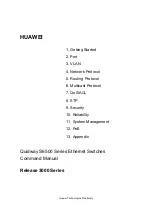
Interfaces
34
Datasheet
When eDP is enabled, the lower logical lanes are still available for standard PCIe
devices, using the PEG 0 controller. PEG 0 is limited to x1. The board manufacture
chooses whether to use eDP and whether to use lane numbering reversal.
The eDP interface supports link-speeds of 1.62 Gbps and 2.7 Gbps on 1, 2 or 4 data
lanes. The eDP and PCI Express x1 may be supported concurrently. eDP interface may
support -0.5% SSC and non-SSC clock settings.
2.4.3
Intel Flexible Display Interface
The Intel Flexible Display Interface (Intel FDI) is a proprietary link for carrying display
traffic from the integrated graphics controller to the PCH display I/O’s. Intel FDI
supports two independent channels; one for pipe A and one for pipe B.
•
Each channel has four transmit (Tx) differential pairs used for transporting pixel
and framing data from the display engine.
•
Each channel has one single-ended LineSync and one FrameSync input (1-V CMOS
signaling).
•
One display interrupt line input (1-V CMOS signaling).
•
Intel FDI may dynamically scalable down to 2X or 1X based on actual display
bandwidth requirements.
•
Common 100-MHz reference clock is sent to both processor and PCH.
•
Each channel transports at a rate of 2.7 Gbps.
•
PCH supports end-to-end lane reversal across both channels (no reversal support
required)
2.5
Platform Environment Control Interface (PECI)
The PECI is a one-wire interface that provides a communication channel between a
PECI client (processor) and a PECI master, usually the PCH. The processor implements
a PECI interface to:
eDP_TX[0]
PEG_TX[15]
PEG_TX[0]
eDP_TX#[0]
PEG_TX#[15]
PEG_TX#[0]
eDP_TX[1]
PEG_TX[14]
PEG_TX[1]
eDP_TX#[1]
PEG_TX#[14]
PEG_TX#[1]
eDP_TX[2]
PEG_TX[13]
PEG_TX[2]
eDP_TX#[2]
PEG_TX#[13]
PEG_TX#[2]
eDP_TX[3]
PEG_TX[12]
PEG_TX[3]
eDP_TX#[3]
PEG_TX#[12]
PEG_TX#[3]
Table 2-3. eDP/PEG Ball Mapping
eDP Signal
PEG Signal
Lane Reversal
















































